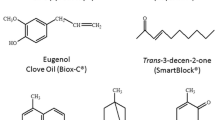Abstract
Endogenous gibberellins (GAs) were extracted from safflower (Carthamus tinctorius L.) stems and detected by capillary gas chromatography-mass spectrometry from which GA1, GA3, GA19,, GA20, GA29, and probably, GA44 were detected. The detection of these GAs suggests that the early 13-OH biosynthetic pathway is prevalent in safflower shoots. Deuterated GAs were used as internal standards and GA concentrations were determined in stems harvested at weekly intervals. GA1 and GA19 levels per stem increased but concentrations per gram dry weight decreased over time. GA20 was only detected in young stem tissue.
Gibberellic acid (GA3) was also applied in field trials and both GA3 and the GA biosynthetic inhibitor, paclobutrazol, were applied in growth chamber tests. GA3 increased epidermal cell size, internode length, and increased internode cell number causing stem elongation. Conversely, paclobutrazol reduced stem height, internode and cell size, cell number and overall shoot weight. In field tests, GA3 increased total stem weight, but decreased leaf weight, flower bud number and seed yield. Thus, GA3 promoted vegetative growth at the expense of reproductive commitment. These studies collectively indicate a promotory role of GAs in the control of shoot growth in safflower, and are generally consistent with gibberellin studies of related crop plants.
Similar content being viewed by others
References
Carlson RD and Crovetti AJ (1990) Commercial uses of gibberellins and cytokinins and new areas of applied research. In: Pharis RP and Rood SB (eds) Plant Growth Substances 1988, pp. 604–610. Berlin, Springer-Verlag
Daniels RW and Scarisbrick DH (1986) Plant growth regulators for oilseed rape. In: Scarisbrick DH and Daniels RW (eds) Oilseed Rape, pp. 176–194. London, Collins
Davis TD and Curry EA (1991) Chemical regulation of vegetative growth. Crit Rev Plant Sci 10: 151–188
Dijkstra P, Ter Reegen H and Kuiper PJC (1990) Relation between relative growth rate, endogenous gibberellins and the response to applied gibberellic acid for Plantago major. Physiol Plant 79: 629–634
Durley RC, Crozier A, Pharis RP and McLaughlin GE (1972) Chromatography of 33 gibberellins on a gradient eluted silica gel partition column. Phytochemistry 11: 3029–3033
Gaskin P, MacMillan J, Frin RD and Pryce RJ (1971) ‘Parafilm’: A convenient source source of n-alkane standards for the determination of gas chromatography retention indices. Phytochemistry 10: 1155–1157
Graebe JE (1987) Gibberellin biosynthesis and control. Ann Rev Plant Physiol 38: 419–465
Harper FR and Berkenkamp B (1975) Revised growth-stage key for Brassica campestris and B. napus. Can J Plant Sci 55: 657–658
Hedden P, Croker W, Rademacher W and Jung J (1989) Effects of the triazole plant growth retardant BAS I11..W on gibberellin levels in oilseed rape, Brassica napus. Physiol Plant 75: 445–451
Jones RL (1983). The role of gibberellins in plant cell elongation. CRC Critical Rev Plant Sci 1: 23–47
Koshioka M, Harada J, Takeno K, Noma M, Sassa T, Ogiyama K, Taylor JS, Rood SB, Legge RL and Pharis RP (1983) Reversed-phase C18 high-performance liquid chromatography of acidic and conjugated gibberellins. J Chromatogr 256: 101–115
Metzger JD (1990) Gibberellins and flower initiation in herbaceous angiosperms. In: Pharis RP and Rood SB (eds) Plant Growth Substances 1988, pp. 476–485. Berlin, Springer-Verlag
Mundel HH, Huang LD, Burch LD and Kiehn F (1985) Saffire safflower. Can J Plant Sci 65: 1079–1081
Murakami Y (1968) A new rice seedling bioassay for gibberellins, ‘Microdrop Method’ and its use for testing extracts of rice or morning glory. Bot Mag Tokyo 81: 31–43
Pharis RP and King RW (1985) Gibberellins and reproductive development in seed plants. Ann Rev Plant Physiol 36: 517–568
Phinney BO (1979) Gibberellin biosynthesis in fungus Gibberella fujikuroi and in higher plants. In: Mandava NB (ed) Plant Growth Substances, pp. 57–78. Washington, Amer Chem Soc
Phinney BO (1985) Gibberellin A1 dwarfism and shoot elongation in higher plants. Biol Plant 27: 172–179
Rademacher W and Jung J (1986) GA biosynthesis inhibitors—an upddate. In: Proceedings of the Plant Growth Regulatory Society of America 1986, pp. 102–133. Lake Alfred, FL.
Rademacher W (1991) Inhibitors of gibberellin biosynthesis: Applications in agriculture and horticulture. In: Takahashi N, Phinney BO, MacMillan J (eds) Gibberellins, pp. 296–310. Berlin, Springer-Verlag
Reid JB, Murfet IC and Potts WC (1983) Internode length in Pisum. II. Additional information on the relationship and action of loci Le, La, Cry, Na, and Lm. J Exp Bot 34: 349–364
Rood SB, Pharis RP and Koshioka M (1983) Reversible conjugation of gibberellins in situ in maize. Plant Physiol 73: 340–346
Rood SB, Larsen KM, Mander LN, Abe H and Pharis RP (1986) Identification of endogenous gibberellins from sorghum. Plant Physiol 82: 330–332
Rood SB, Pearce D and Pharis RP (1987) Identification of endogenous gibberellins from oilseed rape. Plant Physiol 85: 605–607
Rood SB, Mandel R and Pharis RP (1989) Endogenous gibberellins and shoot growth in tBrassica napus. Plant Physiol 89: 269–273
Rood SB, Williams PH, Pearce D, Murofushi N, Mander LN and Pharis RP (1990) A mutant gene that increases gibberellin production in Brassica. Plant Physiol 93: 1168–1174
Rood SB, Zanewich KP and Bray DF (1990) Growth and development of Brassica genotypes differing in endogenous gibberellin content. II. Gibberellin content, growth analyses and cell size. Plant Physiol 79: 679–685
Shanahan JF and Nielsen DC (1987) Influence of growth retardants (anti-gibberellins) on corn vegetative growth, water use, and grain yield under different levels of water stress. Agron J 79: 103–109
Zanewich KP, Rood SB and Williams PH, (1990) Growth and development of Brassica genotypes differing in endogenous gibberellin content. I. Leaf and reproductive development. Physiol Plant 79: 673–678
Zeevaart JAD (1983) Gibberellins and flowering. In: Crozier A (ed) The biochemistry and physiology of gibberellins Vol 2. pp. 333–374. New York, Praeger Publishers
Author information
Authors and Affiliations
Additional information
Author for correspondence
Rights and permissions
About this article
Cite this article
Potter, T.I., Zanewich, K.P. & Rood, S.B. Gibberellin physiology of safflower: endogenous gibberellins and response to gibberellic acid. Plant Growth Regul 12, 133–140 (1993). https://doi.org/10.1007/BF00144594
Received:
Accepted:
Issue Date:
DOI: https://doi.org/10.1007/BF00144594




